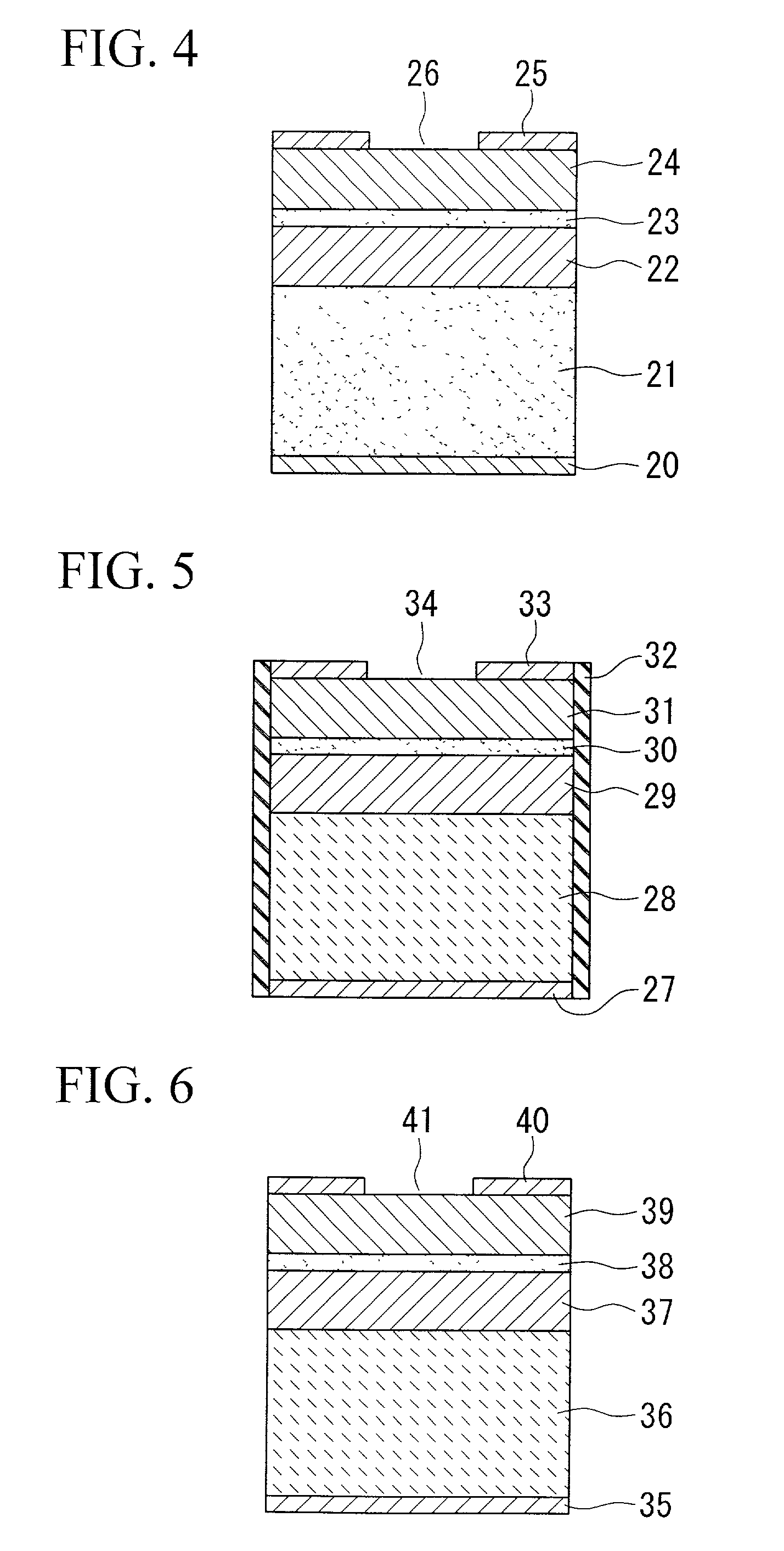Semiconductor light-emitting device
a technology of semiconductors and light-emitting devices, which is applied in the manufacture of semiconductor/solid-state devices, semiconductor devices, electrical devices, etc., can solve the problems of difficult control of epitaxial growth of crystals, low reliability, and high power for operation, and achieves the reduction of the amount of substances applied to the light extraction section, the effect of reducing the diameter of the light extraction section and high emission directivity
- Summary
- Abstract
- Description
- Claims
- Application Information
AI Technical Summary
Benefits of technology
Problems solved by technology
Method used
Image
Examples
examples 1 through 10
[0075] The semiconductor light-emitting device of the present invention was produced by use of an epitaxial wafer for producing a visible-light-emitting device (emission wavelength: 660 nm). The epitaxial wafer was produced as follows. On a p-type GaAs substrate, a p-type Ga.sub.1-x1Al.sub.x1As (0.5<x1<0.8) transparent substrate layer, a p-type Ga.sub.1-x2Al.sub.x2As (0.5<x2<0.8) cladding layer, a p-type Ga.sub.1-x3Al.sub.x3As (x3=0.35) active layer, and an n-type Ga.sub.1-x4Al.sub.x4As (0.5<x4<0.8) cladding layer were epitaxially grown in a successive manner, and then the p-type GaAs substrate was removed. The wafer had a double-hetero structure, a length of 45 mm, and a thickness of 180 .mu.m.
[0076] At The p-type transparent substrate layer and the n-type layer of the wafer were subjected to deposition and alloying of an Au alloy, to thereby form ohmic electrodes. On the electrode which was formed on the n-type layer, openings of 120 .mu.m.phi. were formed at an interval of 350 .m...
example 11
[0082] FIG. 3 shows a cross-sectional view of the semiconductor light-emitting device produced in Example 11. An epitaxial wafer for the semiconductor light-emitting device was produced as follows. On a Zn-doped p-type GaAs single-crystal substrate 13 (thickness: 250 .mu.m), through a liquid epitaxial method, a Zn-doped p-type GaAlAs cladding layer 14 (thickness: 20 .mu.m), a Zn-doped GaAlAs active layer 15 (thickness: about 1 .mu.m), and a Te-doped n-type GaAlAs cladding layer 16 (thickness: 30 .mu.m) were grown successively. In the active layer, the proportions of Ga, Al, and As were regulated to 0.65:0.35:1, so as to attain an emission wavelength of 660 nm. In the p-type cladding layer 14 and the n-type cladding layer 16, the proportions of Ga, Al, and As were regulated to 0.35:0.65:1, so as to transmit light of 660 nm. In the semiconductor light-emitting device produced from the wafer, the GaAs substrate 13 absorbs light of 660 nm, and thus light is not emitted from the surface ...
example 12
[0087] FIG. 5 shows a cross-sectional view of the semiconductor light-emitting device produced in Example 12. In this Example, an epitaxial wafer was produced as follows. On a Zn-doped p-type GaAs single-crystal substrate (thickness: 250 .mu.m), through a liquid epitaxial method, a Zn-doped p-type GaAlAs transparent substrate layer 28 (thickness: 100 .mu.m), a Zn-doped GaAlAs p-type cladding layer 29 (thickness: 20 .mu.m), a Zn-doped GaAlAs active layer 30 (thickness: about 1 .mu.m), and a Te-doped n-type GaAlAs cladding layer 31 (thickness: 30 .mu.m) were grown successively. In the active layer, the proportions of Ga, Al, and As were regulated to 0.65:0.35:1, so as to attain an emission wavelength of 660 nm. In the p-type transparent substrate, and the p-type and n-type cladding layers, the proportions of Ga, Al, and As were regulated to 0.35:0.65:1, so as to transmit light of 660 nm. Subsequently, the GaAs substrate was removed through etching, to thereby form the epitaxial wafer ...
PUM
| Property | Measurement | Unit |
|---|---|---|
| thickness | aaaaa | aaaaa |
| particle size | aaaaa | aaaaa |
| length | aaaaa | aaaaa |
Abstract
Description
Claims
Application Information
 Login to View More
Login to View More - R&D
- Intellectual Property
- Life Sciences
- Materials
- Tech Scout
- Unparalleled Data Quality
- Higher Quality Content
- 60% Fewer Hallucinations
Browse by: Latest US Patents, China's latest patents, Technical Efficacy Thesaurus, Application Domain, Technology Topic, Popular Technical Reports.
© 2025 PatSnap. All rights reserved.Legal|Privacy policy|Modern Slavery Act Transparency Statement|Sitemap|About US| Contact US: help@patsnap.com



